Few trees bloom at the end of the dry season, Millingtonia hortensis, is one of them. Well known by the Lao people, it is however not very common in the gardens.
This large tree native to Burma is recognizable by its long tubular, white and fragrant flowers. It usually blooms twice a year (in December and April) which explains why the fruit, a long green and bumpy capsule, cohabits with the flowers. This beautiful tree does not have a name in French but it has one in English, like many plants originating from the Indo-Malaysian region, where the diffusion of the English language is relatively old.
It was in the pagodas that we first encountered this tree and the monks, when questioned, insisted on its ritual function linked to the sweet smell of its white flowers which, like those of the frangipani tree, are used for sacred offerings.
In profane use, these same flowers are mixed with tobacco to give it an opiate taste or with tea leaves to make them more refreshing.
In Northern Laos, the macerated and beaten bark of kang khong is used to make a beauty cream for the face.
In traditional medicine, the use of this bignone is reserved for throat and lung ailments. The dried flowers are smoked in the treatment of asthma for which a decoction of the root is also prescribed. The ITM recommends boiling the stems and bark of kang khong to stop a stubborn cough and drinking the liquid regularly.
Peu d’arbres fleurissent en fin de saison sèche, Millingtonia hortensis, en fait partie. Bien connue des Lao il est cependant peu répandu dans les jardins.
Ce grand arbre originaire de Birmanie est reconnaissable à ses longues fleurs tubulaires, blanches et parfumées. Il fleurit en général deux fois dans l’année (en décembre et en avril) ce qui explique que cohabitent avec les fleurs, le fruit, longue capsule verte et bosselée. Ce bel arbre n’a pas de nom en français alors qu’il en a un en anglais, comme beaucoup de plantes originaires de la région indo-malaise, où la diffusion de la langue anglaise est relativement ancienne.
C’est dans les pagodes que nous avons d’abord rencontré cet arbre et les bonzes, interrogés, ont insisté sur sa fonction rituelle liée à l’odeur suave de ses fleurs blanches destinées, comme celles du frangipanier, aux offrandes sacrées.
Dans un usage profane, ces mêmes fleurs sont mélangées au tabac pour lui donner un goût opiacé ou aux feuilles de thé pour qu’elles soient plus rafraîchissantes.
Dans le Nord Laos, on fait avec l’écorce macérée et battue de kang khong une crème de beauté pour le visage.
En médecine traditionnelle, l’usage de cette bignone est réservé aux affections de la gorge et des poumons. Les fleurs séchées sont fumées dans le traitement de l’asthme pour lequel on prescrit aussi une décoction de la racine. L’IMT recommande pour faire cesser une toux rebelle de faire bouillir tiges et écorce de kang khong et de boire ce liquide régulièrement.
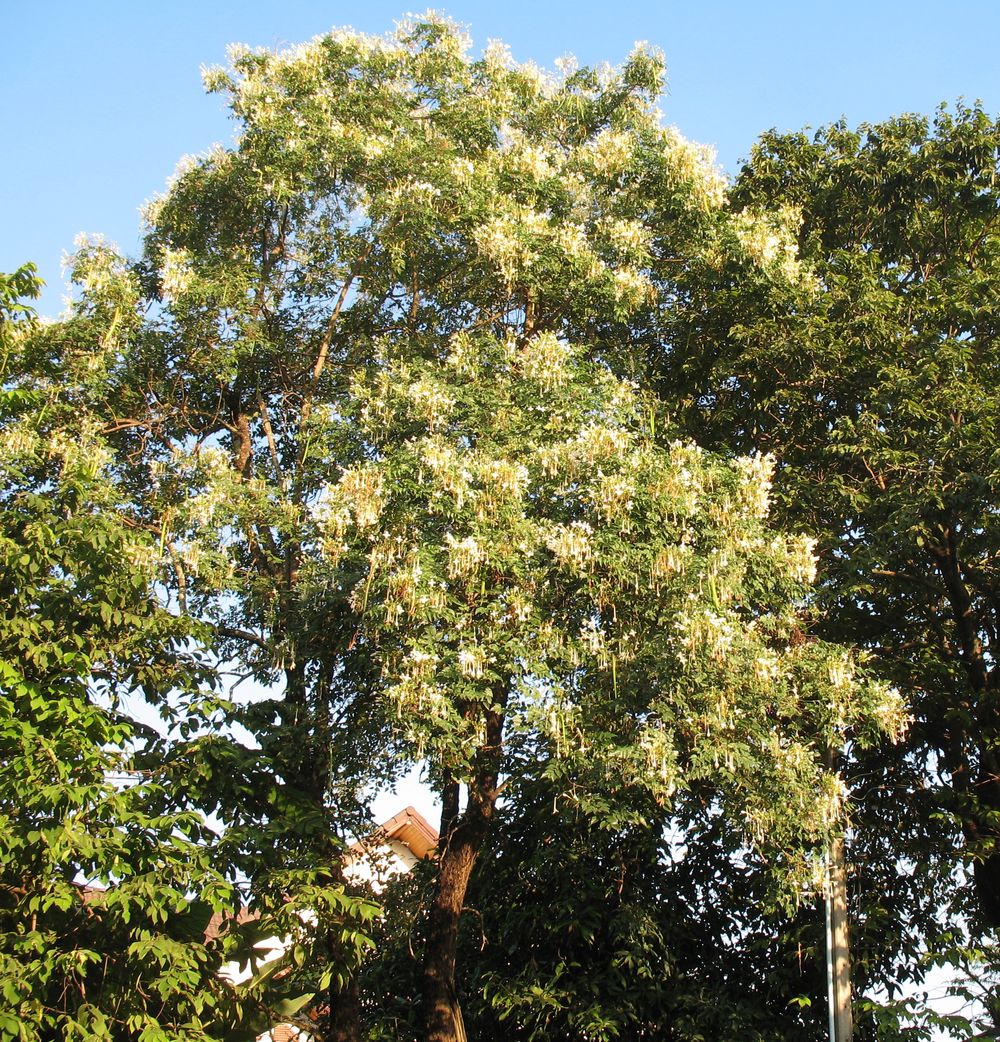
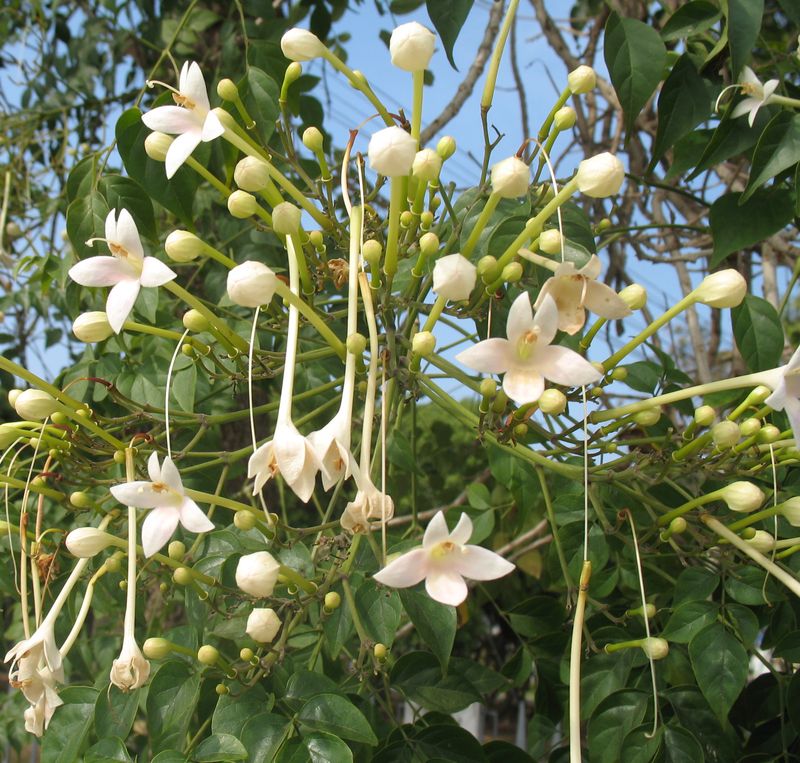
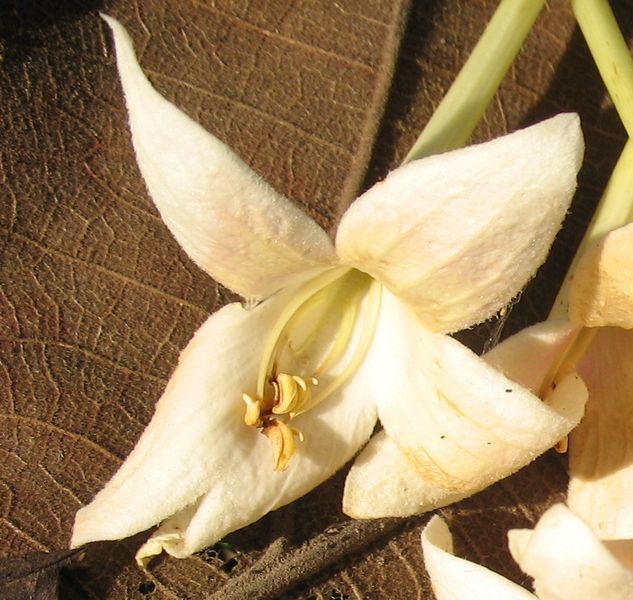
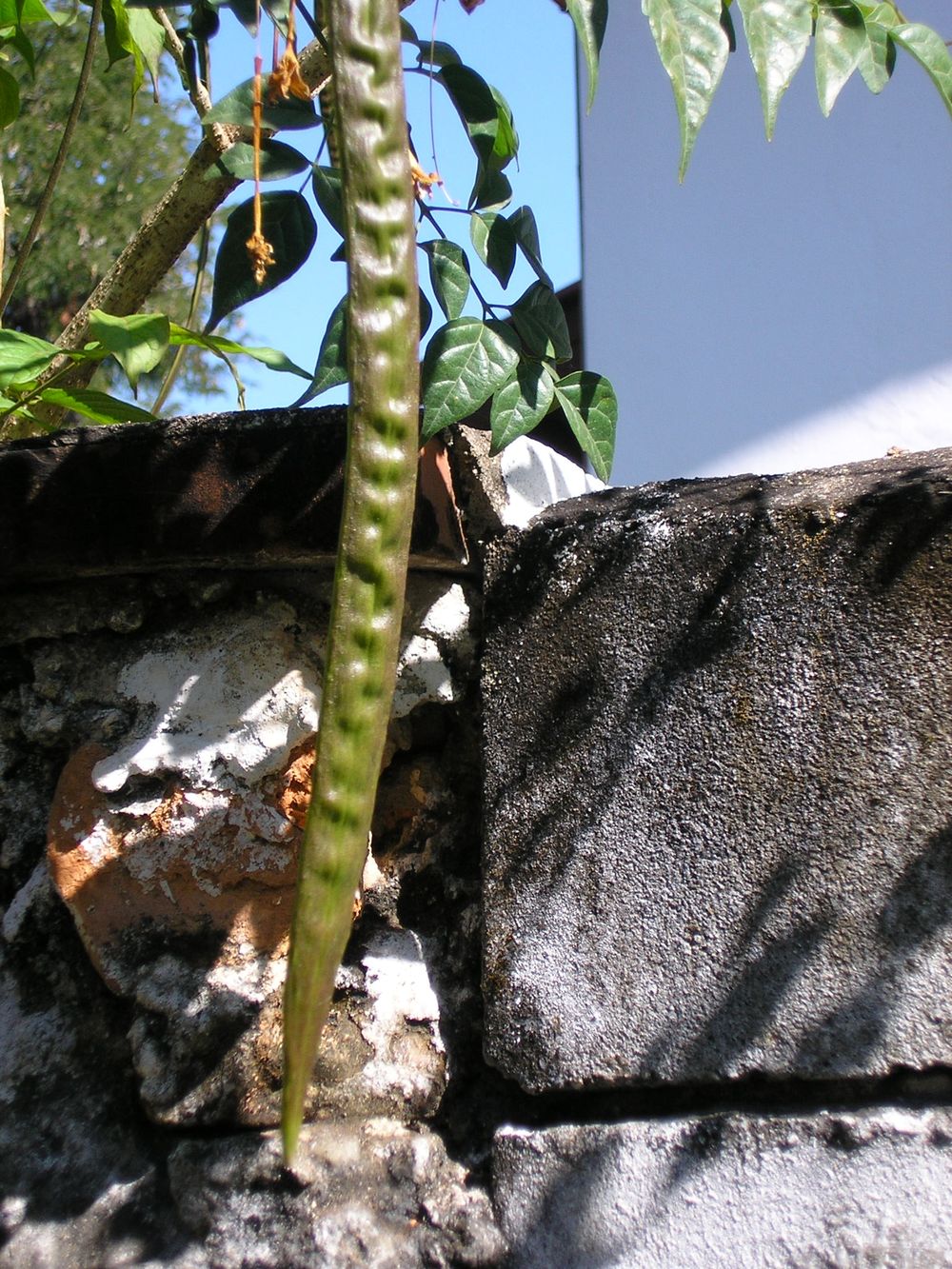
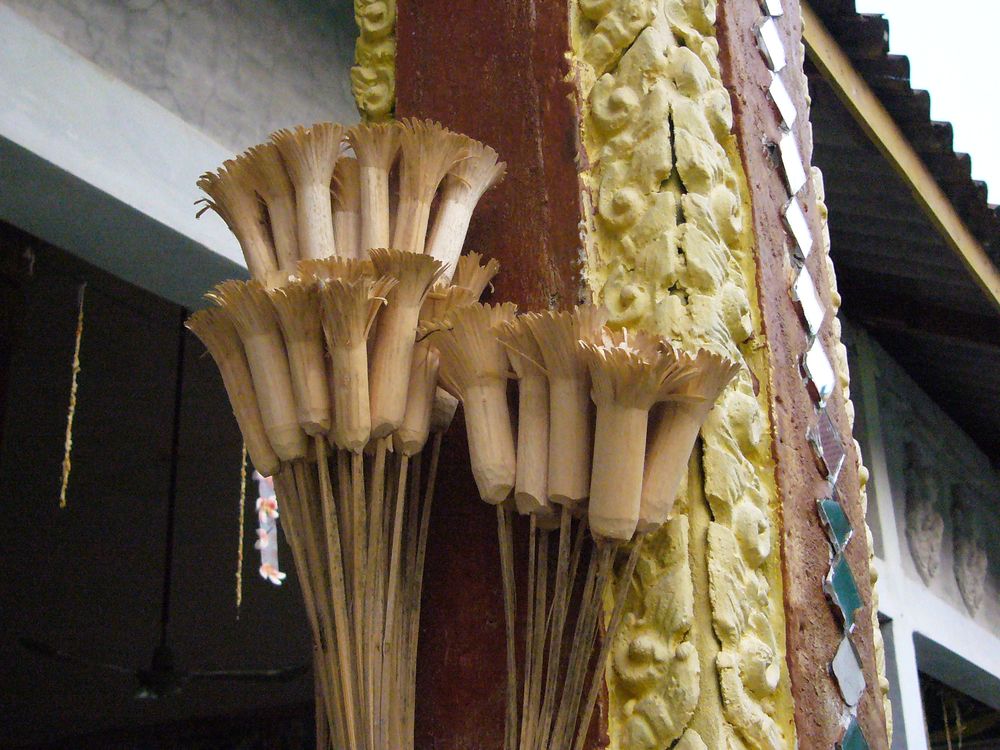
Few trees bloom at the end of the dry season, Millingtonia hortensis, is one of them. Well known by the Lao people, it is however not very common in the gardens.
This large tree native to Burma is recognizable by its long tubular, white and fragrant flowers. It usually blooms twice a year (in December and April) which explains why the fruit, a long green and bumpy capsule, cohabits with the flowers. This beautiful tree does not have a name in French but it has one in English, like many plants originating from the Indo-Malaysian region, where the diffusion of the English language is relatively old.
It was in the pagodas that we first encountered this tree and the monks, when questioned, insisted on its ritual function linked to the sweet smell of its white flowers which, like those of the frangipani tree, are used for sacred offerings.
In profane use, these same flowers are mixed with tobacco to give it an opiate taste or with tea leaves to make them more refreshing.
In Northern Laos, the macerated and beaten bark of kang khong is used to make a beauty cream for the face.
In traditional medicine, the use of this bignone is reserved for throat and lung ailments. The dried flowers are smoked in the treatment of asthma for which a decoction of the root is also prescribed. The ITM recommends boiling the stems and bark of kang khong to stop a stubborn cough and drinking the liquid regularly.
Peu d’arbres fleurissent en fin de saison sèche, Millingtonia hortensis, en fait partie. Bien connue des Lao il est cependant peu répandu dans les jardins.
Ce grand arbre originaire de Birmanie est reconnaissable à ses longues fleurs tubulaires, blanches et parfumées. Il fleurit en général deux fois dans l’année (en décembre et en avril) ce qui explique que cohabitent avec les fleurs, le fruit, longue capsule verte et bosselée. Ce bel arbre n’a pas de nom en français alors qu’il en a un en anglais, comme beaucoup de plantes originaires de la région indo-malaise, où la diffusion de la langue anglaise est relativement ancienne.
C’est dans les pagodes que nous avons d’abord rencontré cet arbre et les bonzes, interrogés, ont insisté sur sa fonction rituelle liée à l’odeur suave de ses fleurs blanches destinées, comme celles du frangipanier, aux offrandes sacrées.
Dans un usage profane, ces mêmes fleurs sont mélangées au tabac pour lui donner un goût opiacé ou aux feuilles de thé pour qu’elles soient plus rafraîchissantes.
Dans le Nord Laos, on fait avec l’écorce macérée et battue de kang khong une crème de beauté pour le visage.
En médecine traditionnelle, l’usage de cette bignone est réservé aux affections de la gorge et des poumons. Les fleurs séchées sont fumées dans le traitement de l’asthme pour lequel on prescrit aussi une décoction de la racine. L’IMT recommande pour faire cesser une toux rebelle de faire bouillir tiges et écorce de kang khong et de boire ce liquide régulièrement.










Few trees bloom at the end of the dry season, Millingtonia hortensis, is one of them. Well known by the Lao people, it is however not very common in the gardens.
This large tree native to Burma is recognizable by its long tubular, white and fragrant flowers. It usually blooms twice a year (in December and April) which explains why the fruit, a long green and bumpy capsule, cohabits with the flowers. This beautiful tree does not have a name in French but it has one in English, like many plants originating from the Indo-Malaysian region, where the diffusion of the English language is relatively old.
It was in the pagodas that we first encountered this tree and the monks, when questioned, insisted on its ritual function linked to the sweet smell of its white flowers which, like those of the frangipani tree, are used for sacred offerings.
In profane use, these same flowers are mixed with tobacco to give it an opiate taste or with tea leaves to make them more refreshing.
In Northern Laos, the macerated and beaten bark of kang khong is used to make a beauty cream for the face.
In traditional medicine, the use of this bignone is reserved for throat and lung ailments. The dried flowers are smoked in the treatment of asthma for which a decoction of the root is also prescribed. The ITM recommends boiling the stems and bark of kang khong to stop a stubborn cough and drinking the liquid regularly.
Peu d’arbres fleurissent en fin de saison sèche, Millingtonia hortensis, en fait partie. Bien connue des Lao il est cependant peu répandu dans les jardins.
Ce grand arbre originaire de Birmanie est reconnaissable à ses longues fleurs tubulaires, blanches et parfumées. Il fleurit en général deux fois dans l’année (en décembre et en avril) ce qui explique que cohabitent avec les fleurs, le fruit, longue capsule verte et bosselée. Ce bel arbre n’a pas de nom en français alors qu’il en a un en anglais, comme beaucoup de plantes originaires de la région indo-malaise, où la diffusion de la langue anglaise est relativement ancienne.
C’est dans les pagodes que nous avons d’abord rencontré cet arbre et les bonzes, interrogés, ont insisté sur sa fonction rituelle liée à l’odeur suave de ses fleurs blanches destinées, comme celles du frangipanier, aux offrandes sacrées.
Dans un usage profane, ces mêmes fleurs sont mélangées au tabac pour lui donner un goût opiacé ou aux feuilles de thé pour qu’elles soient plus rafraîchissantes.
Dans le Nord Laos, on fait avec l’écorce macérée et battue de kang khong une crème de beauté pour le visage.
En médecine traditionnelle, l’usage de cette bignone est réservé aux affections de la gorge et des poumons. Les fleurs séchées sont fumées dans le traitement de l’asthme pour lequel on prescrit aussi une décoction de la racine. L’IMT recommande pour faire cesser une toux rebelle de faire bouillir tiges et écorce de kang khong et de boire ce liquide régulièrement.


